The 2025 Indian Scout has been given its first overhaul in almost a decade and the result is an American cruiser for just about everybody.
It took me a couple of days to understand the approach towards the all-new 2025 Indian Scout. As the entry point to Indian’s range, in its various forms the Scout has accounted for more than 100,000 sales since its launch in 2015, which is more than half of all Indians made during that period.

Kel gets in the groove on the Sport, her favourite in terms of appearance but with a slightly underwhelming braking package
So when the covers came off the first significant model update in almost a decade to reveal a 1250cc Scout whose biggest news was the addition of ABS – no digital dash, no ride modes, no traction control – I really couldn’t understand Indian’s approach to what product director Ben Lindaman called “the largest product launch in the history of Indian Motorcycle”.
But what I eventually came to understand during the three-day launch in northern California was the person who’s buying an American V-twin cruiser has very different needs, wants and motivations than the person who’s perusing the sportsbike, adventure touring or nakedbike segments, for example. And it was through eight months of thorough customer research, where Indian engaged with thousands of customers, dealers and customisers, that the brand understood exactly how it needed to approach the update because, as Lindaman told me, “it’s really easy to go too far”. Given the bike plays a vital gateway role for the historic marque, it was crucial to get it right.
The biggest takeaway from all of that research was that people really loved the current Scout, which is why the new entry-point Scout Bobber doesn’t stray all that far from the current model.
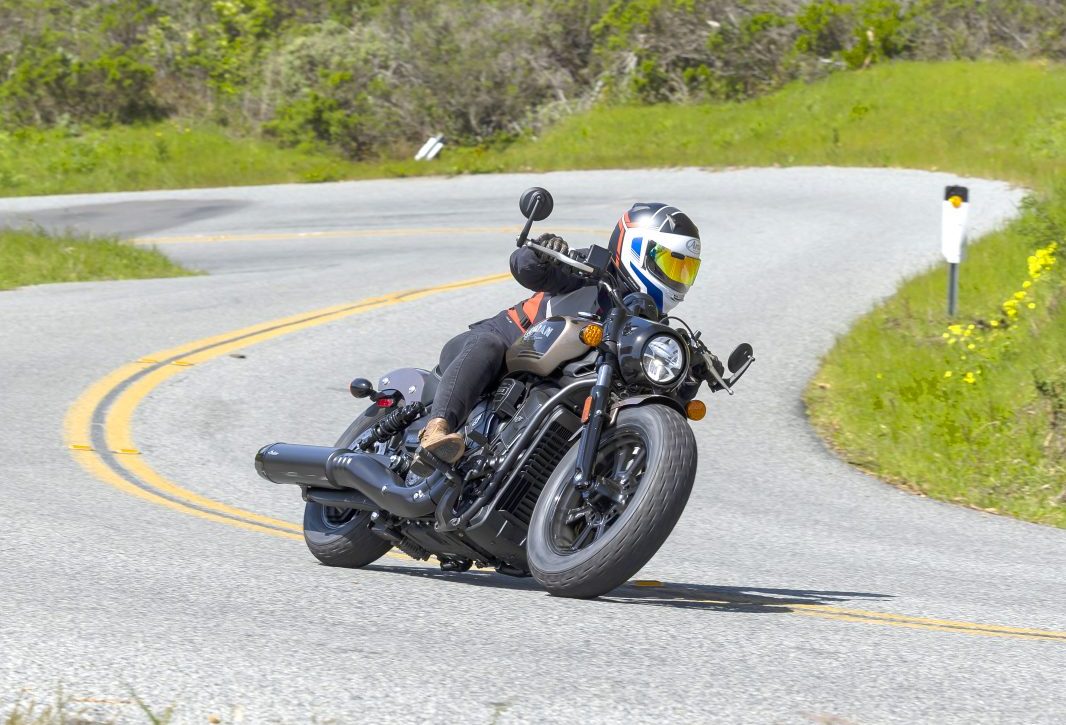
The Bobber was fun to hustle through the corners, despite its claimed 237kg dry weight
The brand also understood that the custom cruiser market couldn’t be ignored, which was the motivation behind switching from an aluminium chassis to a tubular-steel frame, which is far less daunting to work on.
And while this update was prompted by the newest Euro 5+ emission standard, Indian needed to create a platform that can be refreshed and added to for another 10 years, hence features like the all-new plug-and-play electrical architecture. Of course there’s a lot more to the updated platform than the relatively featureless Bobber. Four more models in fact, whose various appointments, ergonomic options and tech packages speak to a wide variety of would-be customers.
To recap, the outgoing range consisted of three models; the $22,995 (ride-away) Scout Bobber, the $23,495 Scout and the $24,495 Scout Rogue. Replacing these three respectively is the Scout Bobber, the Scout Classic and the Scout Sport, with two higher-end models, the Super Scout and the flagship 101 Scout, also joining the stable for the new model year.

The 101 Scout has the best rear suspension with 150mm of travel. In fact it has the best of everything in the range
Common to all bikes is the new tubular-steel chassis and an all-new 1250cc 60-degree V-twin engine. Called the SpeedPlus 1250, the engine replaces the outgoing 1133cc PowerPlus, with the 10 percent capacity increase resulting in a 17 percent increase in power to 79kW (105hp) as well as a 14 percent hike in torque to 109Nm. The 101 Scout gets another six horses again to 82kW (111hp), but this is achieved only through calibration, so the 101’s engine remains mechanically unchanged.
The new subframe is now common to all five models allowing for all racks, seats and luggage options to be interchangeable, while the 2025 fuel tank can accept 375ml more fuel which, thanks to Euro 5+ efficiencies and the tweaked final-gear ratios, Indian says provides 32km more range than the outgoing trio.
There’s also a fuel gauge where there wasn’t one before, and an oil-level sight glass, while servicing has been made more efficient thanks to the valve covers now able to be removed from the side of the bike, rather than having to pull the thing apart in order to access them as on the older models.
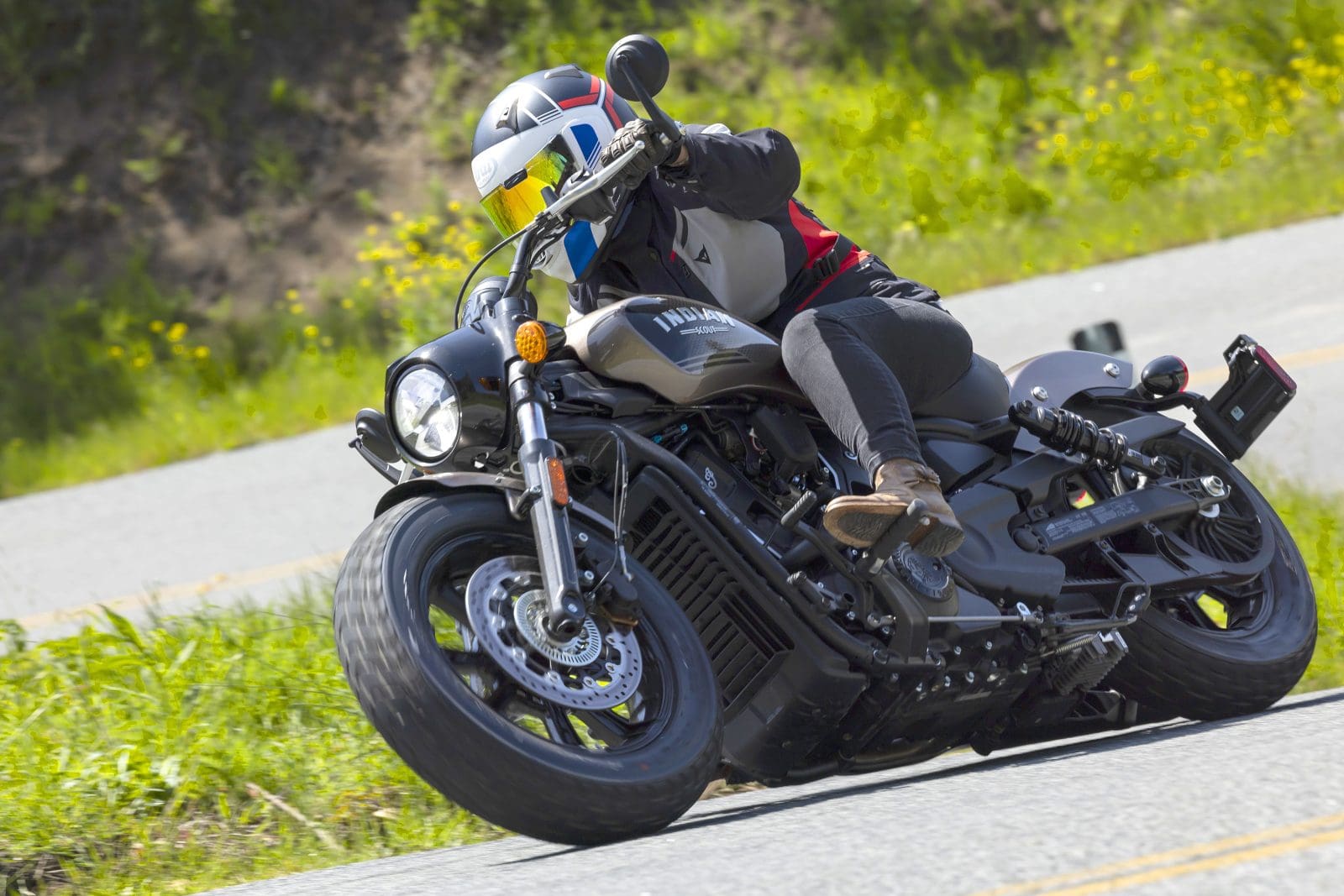
Kel found heaps of confidence from the Bobber’s front hoop
There are quite of lot of differences between the models (see sidebar) but the Bobber, Classic and Super Scout all roll on a 16-inch front wheel, while the 101 and Sport both opt for a 19-inch front, with all five models using a 16-inch rear.
The Super Scout and the Classic’s ergonomics are nearly identical thanks to employing the same pulled-back handlebar, while the Bobber, the Sport and the 101 all use a shorty-style ’bar which forces you into a more aggressive riding position.
I found the riding stance on all five to be a bit of stretch for my 164cm frame, but Indian says as many as 30 different ergonomic options can be achieved through accessing some of the more than 100 different accessories that will be on offer. Indian says mid-mounted ’pegs are a must-have option, according to that extensive customer research, but the part wasn’t ready in time for the launch. A shame, because those, as well as a seat which pushes me closer to the handlebar, would have definitely made for a more comfortable couple of days for me.

All four lower models share the same suspension and braking package, while the 101 gets higher-spec running gear, more powerful lighting, premium paintwork, a machined triple clamp, six-inch risers and that extra power.
In terms of tech, the three base models are available in a trio of trim choices; Standard, Limited and Limited+Tech (see sidebar), while the Super Scout and 101 Scout come only in full-fat Limited+Tech form.
According to the project’s lead engineer Shana Slettedahl, who not only led the team of 120 engineers involved in the Scout revamp but also researched and wrote the project’s entire design brief, once the five target customers were identified and their corresponding models decided on, the platform development began with the top-spec 101 Scout, before then being pared back and tweaked to suit each customer segment.

Northern California has some of the best riding roads in the world. Put it on your bucket list
“There’s a lot of people who like mid-weight cruisers, and we set out to appeal to all of them,” she said.
My Scout experience started with the chrome-laden Classic. It was fitted with the top-tiered Tech+ package, which meant instead of the standard keyed ignition and analogue dash, I was met with a full-colour touchscreen display, a push-button ignition and handful of other aids such as switchable traction control, three selectable riding maps, turn-by-turn navigation and cruise control.
Selecting first gear came with that all-too familiar American clunk. As we left the hotel and picked our way south through San Francisco in search of more appealing forest and coastal roads, my first impressions were average at best. Not helped, of course, by unfamiliar and poorly maintained city roads punctuated by steel plates, potholes and manhole covers, the 76mm of rear suspension travel made itself very well known, first gear was extremely tall and the fueling in the middle Standard ride mode I’d selected seemed fluffy off the bottom. Some bikes feel like you own them the second you jump on them – for me, the Indian Scout was not one of those bikes.
Twenty minutes later, though, I was feeling far more at home. The road surface had improved, I’d realised Sport mode’s throttle feel was far more direct, and now we were through the hustle and bustle of downtown San Francisco the ratios in the higher gears became far more predictable.
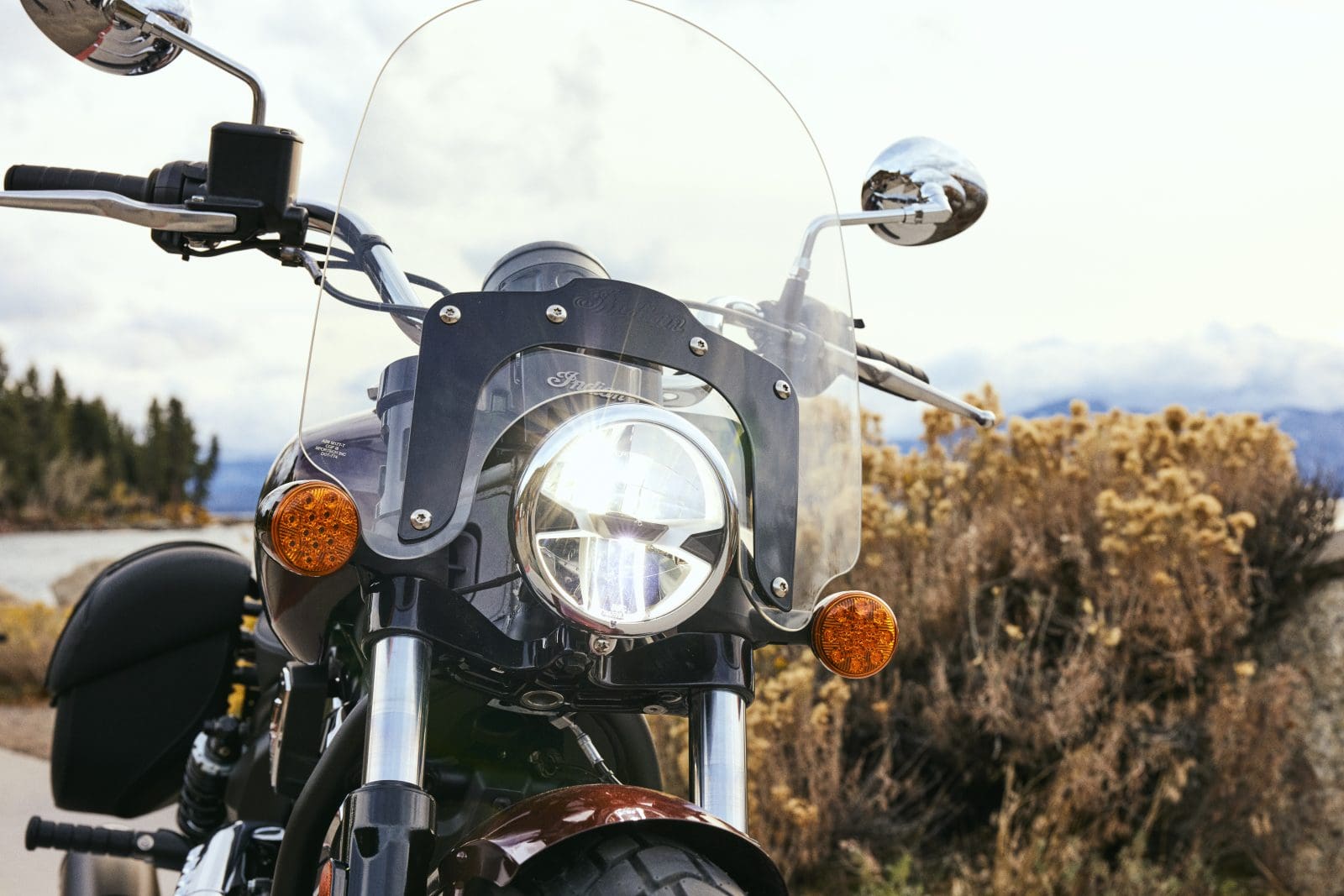
Easy-to-remove screen on the Super Scout
The pulled-back ’bar of the Classic (and the Super Scout) offered the most relaxed ergonomics, although it was still a decent stretch for me, especially when hooking a u-ey at full lock, but not to the point where I ever felt vulnerable or not in complete control. The Scout is the entry point to the Indian brand, and even relatively inexperienced riders will feel comfortable on it. Off the Classic and on to the Bobber, I switched it into Sport mode and adjusted its ’bar-end mirrors, immediately appreciating the excellent vision the Classic’s conventional mirrors provided. We headed into a heavily forested section where the now-quieter road turned tight, twisty and hot-mix smooth. Not generally a fan of a wide, 16-inch front tyre, I was immediately surprised by the amount of feedback I was getting from the 130-section front hoop, helped no doubt by the extra weight I had over it thanks to the hunched riding position of the Bobber.
Buoyed by the front-end confidence, I quickly found the clearance limits of the forward-mounted footpegs, but adjusted my style to suit. Yes, it takes some decent muscle to hustle the 237kg (dry) Bobber through twisty sections of roads at a decent clip – and you do need all the help from both the twin-piston front and single-piston rear calipers biting 298mm brake discs either end – but as long as the surface is in good shape (it only has 51mm of rear suspension travel), the Bobber is more than capable of it.
And the torque delivery of that 1250cc V-twin means you can spend less time dancing through the gearbox, instead relying on the hard acceleration to slingshot you between apexes. There is some transmission snatch if you get your gear selection a little bit wrong, but it’s an otherwise forgiving delivery.

The Classic looks, well, classic and has a lot of old-school features when it comes to the riding experience
Now out of the forest, we took a break in a carpark on the coast where the waves smashing against the rocks indicated the run down Highway 1 to Santa Cruz will be more exposed to the elements. I made a beeline for the only bike in the line-up with a windshield fitted as standard, the Super Scout. As well as non-lockable and water-resistant panniers, it gets wire-spoked wheels, while the windshield itself is a quick-release removable affair – perfect for those riders tossing up between it and the Classic.
The screen itself wasn’t tall enough to keep wind off my helmet. In fact my shorter stature meant it directed any air coming off the screen directly at it but I suspect taller riders would feel the benefits of the screen in keeping the wind off their chests and I’d be certain there will be a bevy of taller or shorter options in the accessories catalogue.
The following morning, we headed inland towards California’s iconic Redwood forests and the hundreds of kilometres of twisty roads that traverse them.

The Classic and Super Scout get wire wheels
I was both grateful for and lamenting the fact that I was on the Sport, one of two 19-inch front wheel Scouts that make up the 2025 range. I was pleased because it took far less inputs from me to flick the bike from side to side – but having the ability to ride fast with more ease meant I didn’t get as much time as I’d like to take in my surroundings, which are some of the oldest forests in the world.
I was on the all-black Sport, which is probably my favourite in terms of appearance. It combines the chopped rear fender and ’bar-end mirrors of the Bobber with a quarter fairing, handlebar risers, mag wheels and blacked-out everything.
As the ancient trees towered above me and the tight twisties opened up into longer more open sweepers I became really aware that the Sport would benefit from a stronger braking package – it’s okay but probably not befitting of a bike employing the Sport moniker.

Which is why I was really glad I left the 101 Scout until the very end. The non-adjustable right-way-up 41mm fork in the previous four models are replaced with a fully-adjustable upside-down 43mm unit with 150mm of travel on offer, 30mm more than its stablemates. Likewise, where the Bobber, Classic, Sport and Super Scout get a single 298mm disc and a no-name twin-pot caliper front set-up, the 101 gets a pair of Brembo monoblock four-piston calipers gripping 320mm discs. The difference is stark.
It’s only one kilogram heavier than the Sport, too, and 19kg lighter than the Super Scout, so between its superior suspension and braking packages and its increased engine performance, you really do notice that you’re on the cream of the crop. There’s a heap of confidence afforded by the Metzeler Cruisetec hoops which adorn the 101 (and the Sport) and the five-spoke mags feel lighter than the Sport’s eight-spokers, just in the ease in which it turns.
Aimed, I suspect, at the rider who wants the bells and whistles of the FTR, but the characteristics of a cruiser, I would have liked Indian to have dialled a little bit more ground clearance into the 101 just so those higher quality appointments could be better exploited. Because as Shana explained to me, “101 wouldn’t have been 101 without extra everything”.

The Super Scout is the most touring-oriented of the five variants
Despite the extra suspension travel, all five seat heights are quoted to be the same 654mm, which really underlines just how accessible the Scout platform is. For those who are wondering about its name, the 101 is a tribute to the 101 Scout that debuted in 1928 as the first update to the much-loved original Scout. With a longer wheelbase, increased rake and lowered seat, it was said to have exceptional handling with some even referring to it as the best motorcycle ever made.
The latest iteration is not perfect. It, and in fact all of the bikes I rode with the digital dash, suffered a few gremlins on start-up – a software glitch Indian assured me will be fixed by the time the production models hit dealer showrooms in Australia this July. The tall first gear (used to help navigate ever-tightening ride-by noise standards) is hard work in congested areas and I found the routing of the rear cylinder’s header pipe unsuited to my seating position, with an uncomfortable amount of heat being thrown on to my right thigh, especially when stationary.
But after riding the 2025 101 Scout, experiencing its extra everything, I was now even more perplexed why the largest product launch in the history of Indian Motorcycle stuck with a featureless analogue dash as standard and mandatory ABS as the sole rider aid on the brand’s all-important entry point. Because if there’s one rider who’s looking for the safety benefits of traction control and a softer ride mode, surely it’s the entry-level rider.
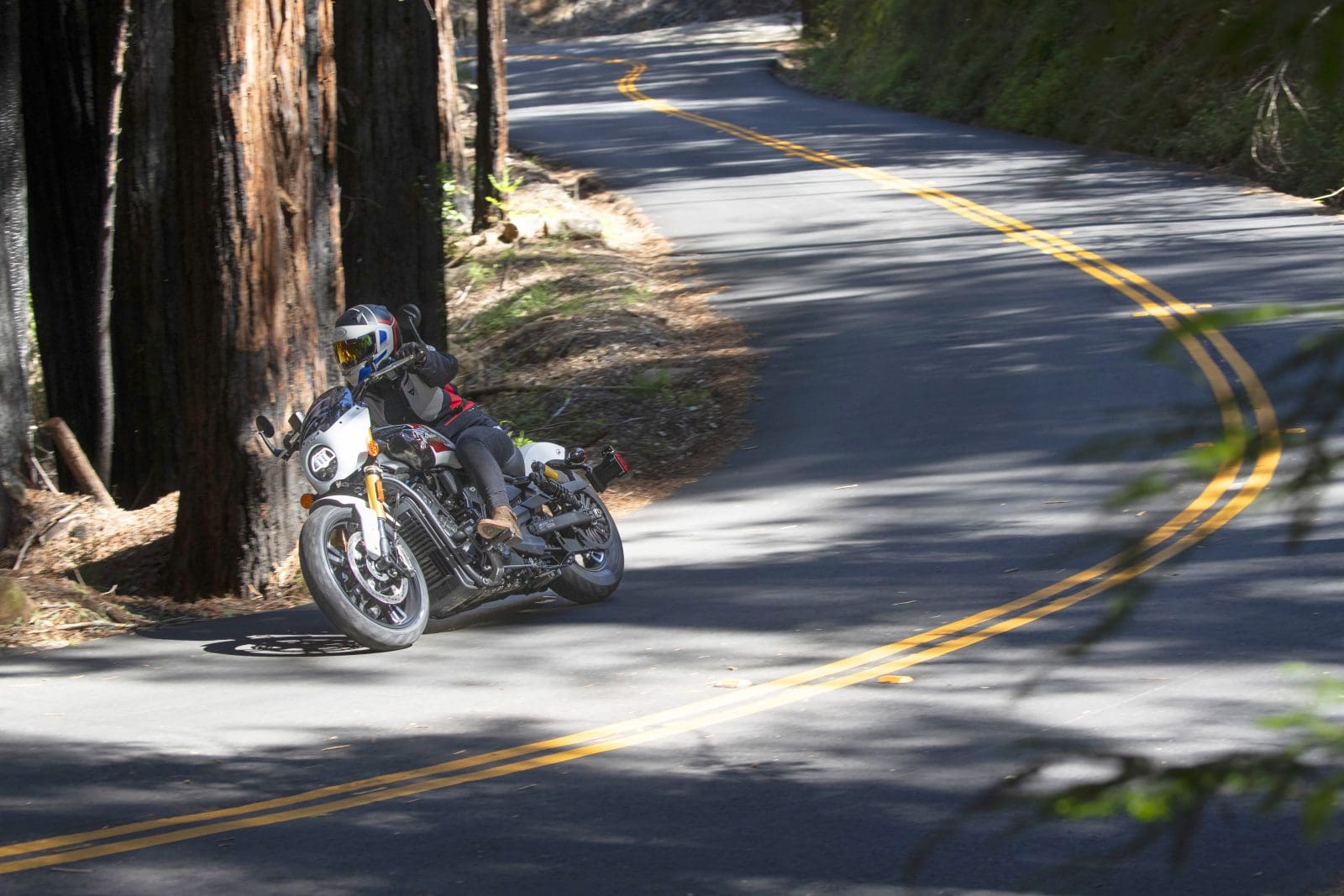
Of course I understand the cost benefits but I put the question to a lot of Indian personnel involved in the project. It was Shana who made it clear.
“Many customers buying an American motorcycle are purists; they don’t want the tech, they want their bike to be raw,” she said. “Those riders don’t get on their bike to be in this world of tech – that’s why we ended up with the tech packages. We didn’t want to take away that raw just you and the wind and a motorcycle – and it’s those purists who we need to keep around.”
So what I initially dismissed as an oversight is in fact a well-researched and conscious decision to appeal to all midsize cruiser owners. And hats off to Indian for the convincing execution.
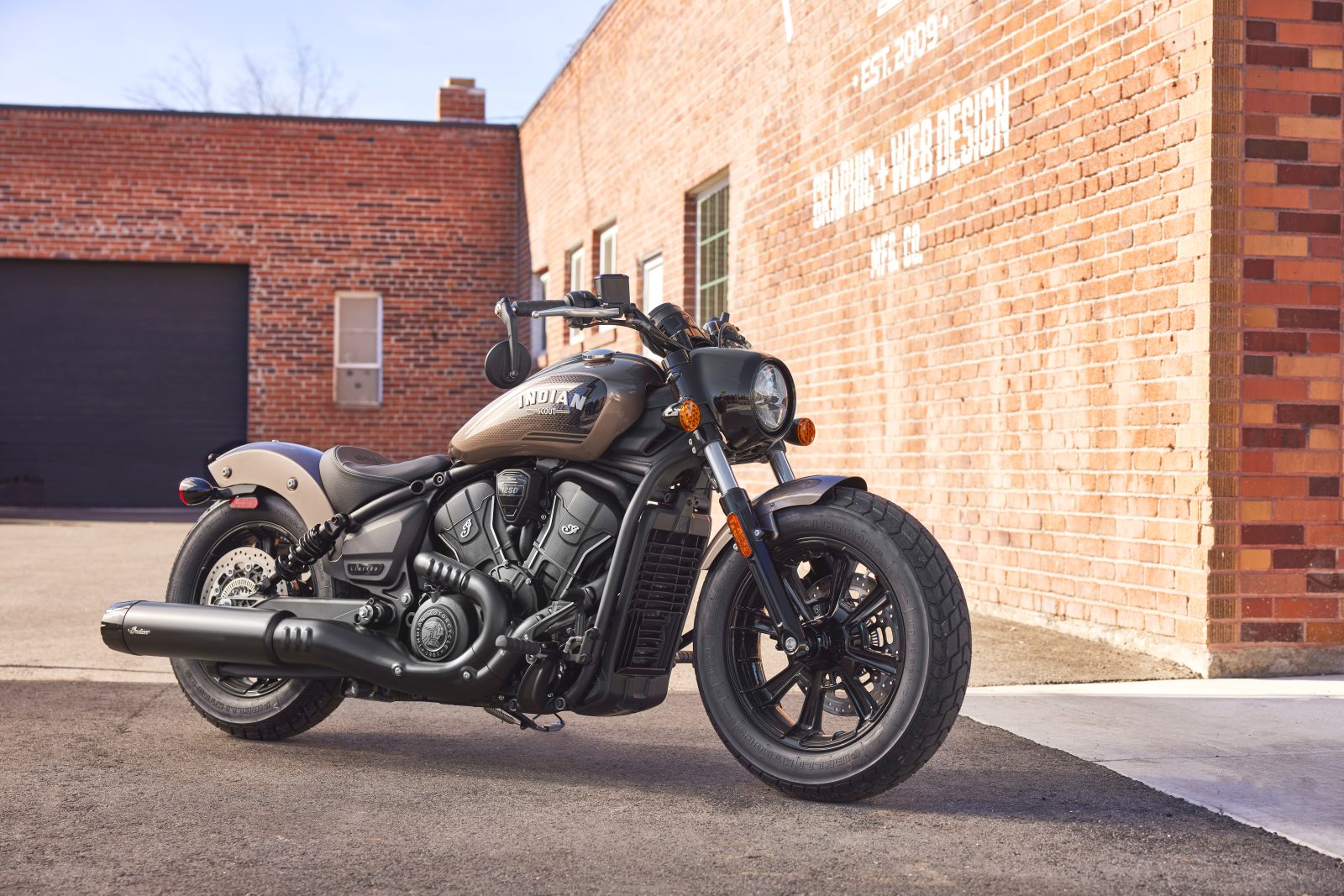
Simple and clean
The design team, lead by the legendary Ola Stenegard, put a lot of work into achieving a clean timeless design. Stenegard said he took a lot of inspiration from what he calls “American surfacing”, which appears on classic American cars.
Less cool
The switch to a tubular-steel frame has been made possible in part to a new radiator that’s 22 percent smaller than before, which now allows it to hide between the frame’s down tubes. The less prominent cooler adds to that cleaner, simple look.
Talent scout
At the heart of the Scout is the all-new 1250cc SpeedPlus 60-degree V-twin engine that, in standard form, produces 79kW (105hp) of power and 109Nm of torque. The calibration of the 101 Scout gives it another six horses to 82kW (111hp).
Open tank
The fuel tank’s capacity has increased by 375ml for 2025, which Indian claims will get you a further 32 kays down the road thanks to the more efficient engine. None of the five models use a lockable fuel cap and the tank capacity is quoted at 13L.
Wide appeal
When the accessories catalogue is made available, Indian says between the different options of seats, footpegs, handlebars and risers, there’ll be no less than 30 different ergonomic options available to Scout owners.
PROS: The power delivery of the SpeedPlus 1250 is smooth and engaging and there’s a Scout model to suit all tastes and, I assume, budgets.
CONS: The tall first gear can be hard work, the standard ergonomics more accommodating and the rear header pipe needs a better heat shield.
TEST: KEL BUCKLEY PHOTOGRAPHY: INDIAN MOTORCYCLE
THE LINE-UP
Scout Bobber: $22,995-$24,995 ride away

The entry point to the Scout platform, its chopped fenders, single seat and ’bar-end mirrors epitomise the moniker. It rolls on 16-inch wheels at both ends, features an all-black engine and exhaust and there’s only 51mm of travel in the rear end.
Scout Classic: $23,495-$25,495 ride away
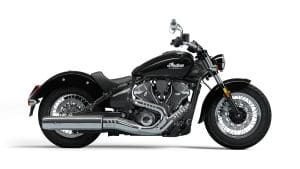
Aimed at the traditionalists, the Classic’s long fenders, pulled-back ’bar and chrome exhaust and engine accents match the bike’s chrome wire wheels and conventional mirrors. Like the Bobber, it rolls on 16-inch wheels but the rear shocks get 76mm of travel.
Scout Sport: $23,995-$25,995 ride away

Speaking to the custom scene, the Scout Sport gets 150mm ’bar risers, a machined triple clamp and a slightly higher seat back. There’s a quarter fairing, a 19-inch front wheel with machined highlights and 76mm of rear suspension travel.
Super Scout: $26,995

With a quick-release windshield and panniers as standard, the Super Scout is aimed at the touring end of the cruiser scene. It has 16-inch wire-spoked wheels, 76mm of rear travel, provision for a pillion and comes with the Limited+Tech pack as standard.
101 Scout: $27,995
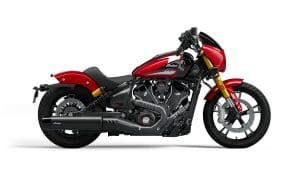
The cream of the crop, the 101 Scout gets more horsepower dialled in, fully adjustable suspension at both ends, a twin-disc Brembo front end and premium paint. There’s 150mm gloss black ’bar risers, a custom-stitched solo seat and the full-fruit electronics package.
MR PRESIDENT

Mike Dougherty has been at Polaris for 26 years and was appointed President of Indian Motorcycle in 2019
Where are the bikes being manufactured?
All the heavyweights and all bikes for North America are produced in our Spirit Lake Iowa facility. We have a factory in Poland where all the mid-sized – so FTR and Scout – for Europe and Eastern Africa are built. Polaris had a factory there already, so it helps not only with logistics, but also when we had some trade disputes.
We’re opening up a factory in Vietnam where Scouts will be built for all of the Asian markets plus Australia. We’ve been building bikes there now for a couple of years but the Scout line opened on 16 April.
How important is the Scout in Southeast Asia?
Scout is the highest volume in Asia. Half of our volume for Scout is outside the US, and I would say one third of
that volume is in Asia. But we need it to be more. We’ve been exporting them from Iowa, while all of our competition has a Thai factory or an Indian factory, and we’ve been paying 25 percent duties. Also the time and the freight
is expensive.
Is a joint venture on the radar?
We’ve had a joint venture with VPIC, in Vietnam, for components for a while; chassis, for example. Metal stamping, forging, welding… that’s their thing. We’ve had partnerships in the past, but we’ve never been able to find that perfect partner.
We think Indian is super special and finding a partner – they always want more than we want to give, so it’s hard to find that strategic alignment. We have enough scale now that we can do it ourselves. Polaris is big and we think Indian is going to be big. And so we’re going to do it our way. We don’t have to compromise.
Would a small-capacity Indian make sense in the Asian market?
Trying to grow businesses in Asia in particular, having a smaller capacity motorcycle would be really great. The problem for us is being able to get the volume and the price point to compete against excellent competitors – the Bajas, the Heros – their operational excellence is really impressive.
So no small-capacity offering in the short or medium term?
Probably not in the 300-500cc category, I don’t know how we’d compete in that. But something smaller than a 1250 or 999 makes sense to me. Where it’s still premium, it’s still an aspirational spot.
Does Polaris still own electric brand Brammo?
We dissolved that. No, that didn’t work out. We made that Victory Empluse. I think people enjoyed the bike but it cost us $20k to build it and people bought it for $12k, so it’s just not a business.
We partnered with Zero Motorcycles for [Polaris] off-road vehicles and we’ve looked at it on the motorcycle side, but it’s just such a small market right now.
We’re always monitoring it, but when you look at where you’re going to spend your next dollar on product development, we don’t see electric motorcycles as being the next great thing for us.
THE TECH OPTIONS
Standard
Aimed very much at the purists, the standard package consists of an analogue dash with a fuel gauge and economy counter, non-switchable ABS and LED lighting. Bobber, Classic and Sport owners can choose between all three tech trims.
Limited
The Limited tech package adds switchable traction control and cruise control to the electronic rider aids, as well as three switchable engine maps in Sport, Standard and Tour. The Limited options adds a USB outlet, but not phone connectivity.
Limited+Tech
Standard fitment on both the Super Scout and the Scout 101, the Limited+Tech pack adds a coloured touchscreen dash to the mix, turn-by-turn navigation, configurable gauges, ride stats and keyless ignition. Connectivity is available through Indian’s Ride Command app.
SPECS
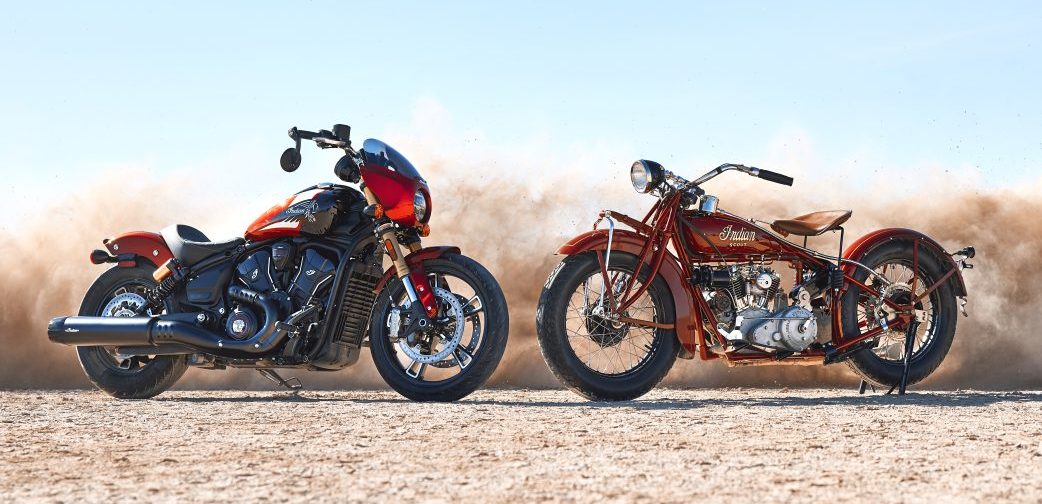
ENGINE
Capacity 1250cc
Type 60º V-twin, DOHC, four valves per cylinder
Bore & stroke 104mm x 73.6mm
Compression ratio 12.5:1
Cooling Liquid
Fueling EFI, 60mm throttle bodies
Transmission Six-speed
Clutch Wet, multi-plate
Final drive Belt
PERFORMANCE
Power 79kW (105hp) @ 7250rpm
101: 82kW (111hp) @ 7250rpm (claimed)
Torque 108Nm @ 6300rpm
101: 109Nm @6300rpm (claimed)
Top speed 185km/h (est)
Fuel consumption 6.5L/100km (avg)
ELECTRONICS
Type Not given
Rider aids ABS. 101 & Super Scout: ABS, Traction control and cruise control
Rider modes Not applicable
101 & Super: Sport, Standard & Tour
CHASSIS
Frame material Tubular steel
Frame type Double cradle
Rake 29°
Trail 123mm Bobber: 125mm
Wheelbase 1562mm
SUSPENSION
Type Indian
Front: 41mm fork, 120mm travel
101: 43mm USD fork, fully adjustable, 150mm travel
Rear: Dual shocks, preload adjustable, 76mm travel Bobber: 51mm travel
101: Dual piggyback shocks, fully adjustable, 76 mm travel
WHEELS & BRAKES
Wheels Classic & Super Scout: 40-spoke wire; Bobber & Sport: 8-spoke cast;
101: 5-spoke cast
Front: Classic, Bobber & Super Scout:
Front: 16 x 3.5 Rear: 16 x 3.5
Sport & 101: Front 19 x 3.5 Rear 16 x 3.5
Tyres Classic: Pirelli Night Dragon Bobber: MT60RS/Night Dragon
Super Scout: MT60RS
Sport & 101: Metzeler Cruisetec
Front: 130/90-16
101 & Sport: 130/60-19
Rear: 150/80-16
Brakes
Front: Single 298mm disc, twin-piston caliper
101: Twin 320mm discs, four-piston Brembo calipers
Rear: Single 298mm disc, single-piston caliper
DIMENSIONS
Weight Classic: 243kg, Bobber: 237kg, Sport: 239kg, Super: 259kg, 101: 240kg (dry, claimed)
Seat height 654mm
Width Not given
Height Not given
Length Not given
Ground clearance 113mm Bobber:109mm
Fuel capacity 13L
SERVICING & WARRANTY
Servicing First: 1000km
Minor: 8000km. Major: 16,000km
Warranty Two years, unlimited km
BUSINESS END
Price TBC
Colour options 18 options
Contact indianmotorcycle.com.au